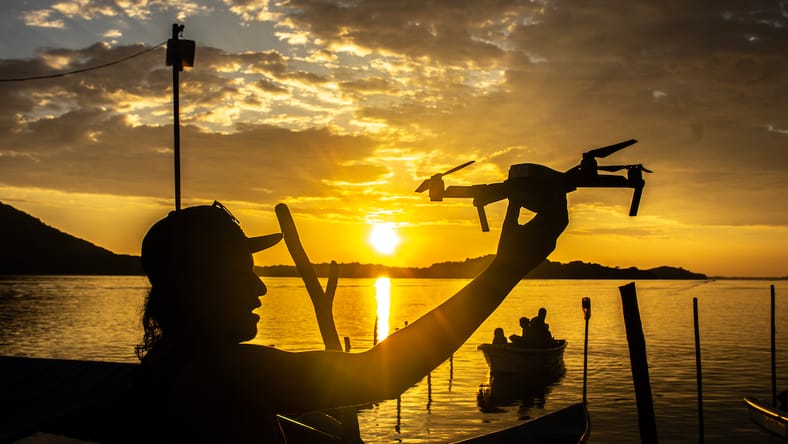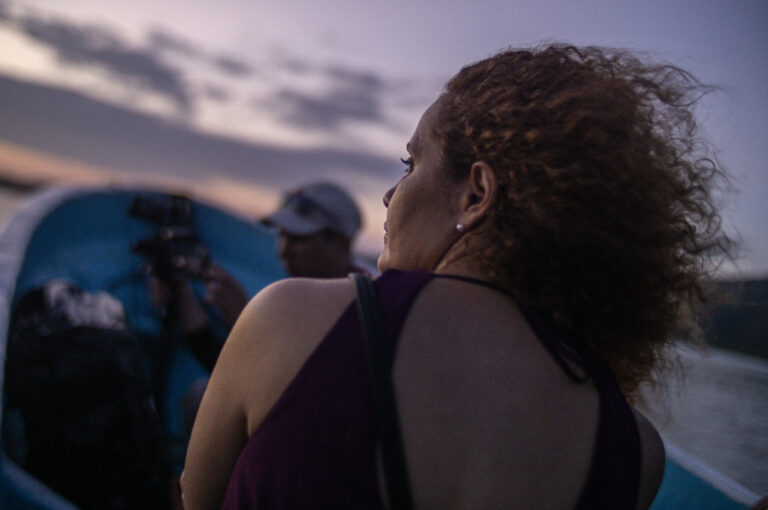
Anike Tourse wrote, directed, and stars in America’s Family, which won the 2022 Dances with Films Audience Award and Grand Jury Prize. Anike is a multimedia maker who prides herself on leading teams of predominantly women and people of color. In this piece, she talks about the parts of the production shot in Mexico — and whittling down a several-week schedule to 11 days. —M.M.
When my fellow American producer Nadia Voukitchevitch and I met for the first time with two Tijuana-based producers, we felt a combination of nerves and potential.
Potential because the two Mexican women — Paulina Villalba and Diana Haro — had worked on fairly big projects, including the biopic Netflix series Luis Miguel and the Gina Rodriguez thriller Miss Bala. But nerves because this would be their first time as lead producers.
It seemed like a lot of firsts all around, being that this was my first feature, and I had never gone to film school. Whatever we lacked in experience, however, we made up for in ganas — intense desire.
We had interviewed other highly capable and experienced Mexican production companies, but they all came in with budgets far beyond what we could afford — $150,000 for the Mexican part of our U.S.-Mexican shooting schedule. We couldn’t fly a U.S. crew to Mexico and house them there, particularly as we were going to extremely remote areas in Oaxaca.
These areas included Afro-Mexican communities along the coast that were very significant to our story. While these communities were very warm and welcoming, I worried about how four women would handle production in towns where Mexican patriarchal culture is the strongest. But the reality was that we didn’t have much choice.
We planned to film in Oaxaca, and then Tijuana. But before that could happen, our first task together was to figure out how to get the money into Mexico. Given our low budget, we had reassured crew members by promising to pay them in cash, in U.S. dollars. But that meant actually getting the money across the border. At one point, someone suggested that we walk across with cash taped to our bodies, which I flatly refused to do — I don’t even like walking around with a lot of cash in the U.S., much less another country.
Eventually I found myself in a long line at a Tijuana bank, which gave me plenty of time to stress about how to open an account without a Mexican address. Fortunately, we ended up with a patient and supportive banker who opened the account in my company name. I was now handling more money than I ever had before, and it took a lot for me to trust my new team with it. Looking back on it, I wonder if perhaps our non-profit executive producer felt this way about me, too.
Also Read: In Mija, a Music Manager Helps Her Undocumented Parents by Discovering Pop Stars
Soon we headed to our first location scout and met members of a Tijuana-based crew. They knew the context and sensibility of the city’s simultaneous grit, desperation, and possibility. The border is always in flux, and given a massive increase of Central American migrants at the time of our shoot, 2018, no one needed a lesson on the timeliness of our story. But we talked in depth about what was happening for immigrants in the United States, particularly for mixed-status immigrant families.
America’s Family was largely funded by grants that include the Los Angeles Arts Commission and Dr. Bronner’s Family Foundation, and it was executive produced by Angelica Salas, the executive director of the non-profit the Coalition for Humane Immigrant Rights (CHRLA). It so happened that CHIRLA attorneys were working at the border, as we shot nearby, to counsel migrants seeking asylum. We started to better understand that we weren’t just making a movie: Our story could be an organizing tool for families and their communities to help and protect each other.

Dawn for America’s Family
A month later, we landed along the Oaxacan coast to start shooting in the little beach town of Cacalote — the famous “Heaven’s Mouth” seen in Alfonso Cuarón’s Y Tu Mama También. It was 5 a.m. — not so early when you’re planning to shoot a movie — but a key member of our crew had yet to arrive.
I had deliberately chosen Oaxaca for filming as it was known to be safer than the backroads of Guerrero, the state where I had done my principal research. But Mexico is never predictable. The road off the highway was long and ran deep into the bush, with no cell reception. I silently panicked, imagining our expensive camera equipment being hijacked, and thinking of Carlos Munoz Portal, a location scout for Netflix’s Narcos who had been killed a year before, near Hidalgo.
Our director of photography, Christian Misael Palma Montaño, and his team stayed surprisingly cool, assembling their lighting equipment. It included cardboard stuffed with lightbulbs, held together by splitters and covered with tin foil. The idea was to create a diffused POV shot from a hut we were all huddled inside. We took our first shots, of our lead actor, Ricardo Cisneros, waking up to the spectacular sunrise.
Then the missing crew member arrived. He was fine.
The Professionalism of Our Mexican Local Crew
The America’s Family crew was endlessly resourceful. Film schools in Mexico take a comprehensive approach, teaching all students to become proficient in most positions on set. Our sound mixer, Saulo Cisneros, was also an exceptional photographer, which was invaluable when we needed behind-the-scenes photos. One of our ambitious co-producers, Diana Haro, did double duty as our first assistant director. Also, when you rent a valuable camera in Mexico City, it comes with a person attached as its onsite guardian. We quickly integrated this person, Emilio Medrano, into the team, and we were grateful for the extra help.
Every day began before sunrise and went into the wee hours of the night. I remember working more than one 16-hour shooting day, which I would not recommend. In spite of the long hours, relentless heat, and mothball-sized mosquitoes, no one complained. The team worked at maximum capacity with no prompting from me.
We had two production assistants, Javier Gonzales and Carlos Villalba, who essentially worked for everyone, and I have no idea how they managed under that kind of pressure. Everyone treated each other with enormous respect. People answered my questions with “si, directora” or “no, directora.” They modeled an exceptional level of efficiency and formality that I cannot imagine for a cast and crew of this size in the U.S.
And they were brave. When we needed close-ups of Ricardo surfing — he had just learned — the crew boarded our small boat and headed out into the open sea. They strapped a GoPro to his surfboard, set up a drone and telephoto lens — and we waited. It was one of the calmest days of the surfing off-season. But when a workable wave rolled through, the pelicans miraculously took off, and entered the frame at the exact moment our novice surfer popped up on the glorious green Pacific.
Our America’s Family crew also connected us to communities that became a vital part of production. Our community liaison, Victor Jose Campos Saucedo, introduced us to the women who ran a local fishing and turtle conservancy co-op, and they convinced strong-willed fishermen to steer boats on-camera for our meticulously choreographed fishing setups.
Our casting director, Aurora Barsotti, found actors for two key supporting roles, and most of the background actors, by going door-to-door. She repeatedly reiterated our mantra that this was the rare opportunity for both decent-paying work and the chance to represent Mexicans of African descent who are too rarely seen onscreen.
At the end of six days in Oaxaca, we raced to the airport for our four-day shoot in Tijuana. The inexpensive flights were strung together with connections through the night so that we could shoot the next morning. We shot along a stretch of the border wall, outside of nightclubs, and at the Casa del Migrante, a shelter home that has helped more than a quarter-million vulnerable immigrants over nearly three decades. Many of the migrants worked at construction sites, and we paid better.
The managers at Casa del Migrante, who had been supportive of the project early on, ended up less than thrilled at how invasive filming soon turned out to be — after all, the Casa was a place for people to eat and sleep and rebuild their lives, and was not intended to be a movie set. In the final hours of filming, we blocked the door of one room to make sure they wouldn’t interrupt and kick us out. (They didn’t.)
Years later, after completing the U.S. portion of production, we returned to Mexico to share America’s Family in honor of those who helped make it. We felt a strong sense of pride from the family of artists and activists who helped us complete our film.
Family is one cornerstone of Mexican culture. Hard work is another. We couldn’t have made our film without both.
America’s Family is now available on all major VOD platforms.
Main image: America’s Family second assistant camera operator Erick Diaz launches a drone.
Editor’s Note: Corrects byline.
